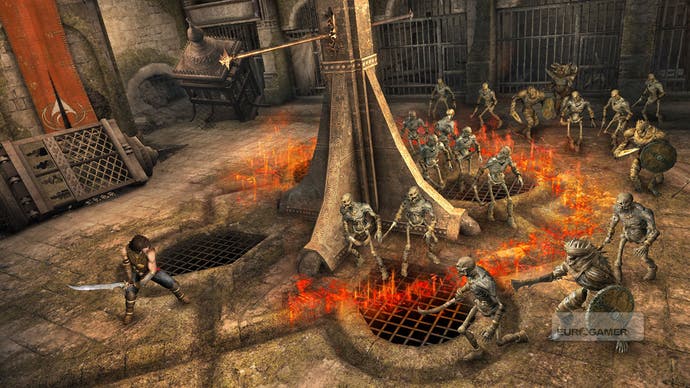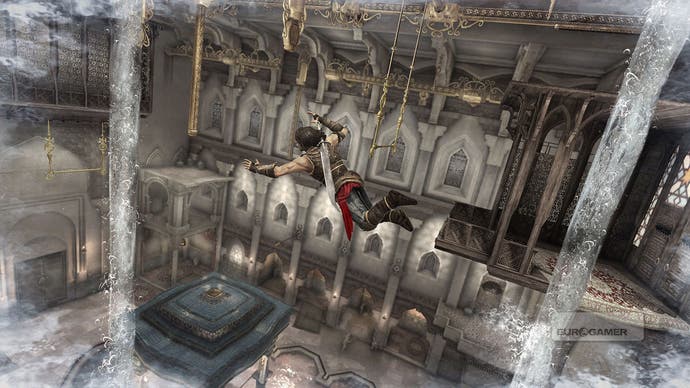Prince of Persia: The Forgotten Sands
Once more unto the beach.
"It's not the game of the movie, the movie is the movie of the game." That's the official line about this latest Prince of Persia do-over's relationship to the upcoming Jake Gyllenhaal blockbuster. One look at the cover art, huge standees of which adorn the room I'm playing The Forgotten Sands in, proves this isn't exactly a total separation of console church and silver-screen state, however. Donnie Darko's face might be replaced by that of a handsome, swarthy stranger, but the hair, the clothes, the pose, the font are a spit for the movie's poster.
And why not? The movie is, after all, based loosely upon The Sands of Time, the last-generation title that spectacularly reinvented classic, big-trousered early-nineties platformer Prince of Persia. Curiously, The Forgotten Sands is a direct sequel to that, slotting into the Prince's narrative in a newly-created gap between Sands of Time and the unfortunate rawk stylings of The Warrior Within. This means bolshie royal-lady Farrah returns, as does the titular wibbly-wobbly timey-wimey rewind-o-sand.
And as does Sands of Time's fluid, elegant parkour-as-puzzle structure. There's plenty of combat - largely against armoured skeletony things - in The Forgotten Sands, but the focus is on navigating across environments filled with traps and ledges and dangling lights and giant levers. It's always a game about getting from A to B, but that involves mastering complex timing, controls and observation. In concept, it's finally giving The Sands of Time's many fans what they want after years of puzzling deviations from what was clearly a successful formula.

This means it's the polar opposite of 2008's Prince of Persia - a failed attempt to reboot the series again - whose style and story now seem abandoned. While the case for the defence was that it was aimed at non-traditional gamers, the general consensus was that it was too easy - you presses your buttons and the game does it all for you. Hoo boy, this one's not the same. While my limited playtime saw me plunged directly into the eighth level, and thus not pre-tutored in Forgotten Sands' intricate thinking and controls by hours of practice, the difficulty was still a shock.
I suspect we've been spoiled by the button-holding fluidity of Assassin's Creed, the neon-bright signposting of Uncharted 2, and the just-keep-going urgency of Mirror's Edge. The Forgotten Sands gives you a quick scan of each room when you enter it and tries to point the camera in roughly the direction you next need to head, but other than that you're on your own.
Its acrobatics-based puzzles are strictly square-peg-in-square-hole affairs, so you won't progress until you've sussed out the one and only way to reach the next ledge or pole or chandelier. Even then, getting there requires very quick button combos and reflex-jumping, else you'll fall to the floor, damned either to death or taking the lengthy manoeuvre from the top.

It's possible The Forgotten Sands is going to be too frustrating for some players, as the muted art style means it seem occasionally tricky to gauge depth and distance, and at least twice I thought I'd accidentally looped back on myself because the latest room looked so similar to the last.
Meanwhile, the few-and-far between checkpoint system means you have to repeat a fair old stretch of wall-running, pole-vaulting and skeleton-smashing upon each all-too-regular death. Again, this is based on jumping directly into a late stage of the game, so hopefully it'll feel a lot more natural if you've come to it the normal way.








